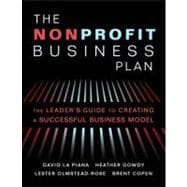
Note: Supplemental materials are not guaranteed with Rental or Used book purchases.
Purchase Benefits
Looking to rent a book? Rent The Nonprofit Business Plan [ISBN: 9781618580061] for the semester, quarter, and short term or search our site for other textbooks by LA Piana, David; Gowdy, Heather; Olmstead-rose, Lester; Copen, Brent. Renting a textbook can save you up to 90% from the cost of buying.
The New copy of this book will include any supplemental materials advertised. Please check the title of the book to determine if it should include any access cards, study guides, lab manuals, CDs, etc.
The Used, Rental and eBook copies of this book are not guaranteed to include any supplemental materials. Typically, only the book itself is included. This is true even if the title states it includes any access cards, study guides, lab manuals, CDs, etc.
From Chapter 1:What is a Nonprofit Business Plan and Why Do You Need One?
Consider the following statements:
“Business planning is for businesses and strategic planning is for nonprofits.”
“A business plan is just a strategic plan with numbers attached.”
“I don’t need a business plan, I need a business case.”
These are some of the statements we have heard from clients in the course of discussing and engaging in business planning over the last several years. Each is built on certain assumptions common in the nonprofit sector.
“Business planning is for businesses and strategic planning is for nonprofits.”
This statement revives the old concept of nonprofit exceptionalism. After being told for more than two decades that they should operate more like businesses, nonprofits sometimes rebel, asserting that the distinct role, financing, and culture of most nonprofits make them completely different from businesses. We prefer Paul Light’s now-classic exhortation that in response to such arguments nonprofits should try to become “more nonprofit-like.”1 That is, nonprofits live in an economic world just as businesses do, but they have an essentially different function in society and therefore need to use caution in adopting business tools and business thinking wholesale. The bottom line: a nonprofit needs a business plan just as much as a business does, perhaps more so given the narrower room for experimentation and the high consequences of failure—both of which can be traced back to often-narrow operating margins and lack of adequate capital. But that business plan must be tailored to the unique needs of each nonprofit as it navigates its own complex path. Just as a manufacturing company executive would not tolerate being forced into a business planning process designed for a retail business, nonprofits need a business planning process that fits with their sector’s, and their organizations’, requirements.
“A business plan is just a strategic plan with numbers attached.”
This second statement implies that a strategic plan is still the basic document required for establishing a nonprofit’s direction and that to undertake business planning simply means adding a budget to that document, perhaps in an appendix. Such an approach reflects a missed opportunity. A solid business plan goes beyond articulation of strategy and projection of revenues and expenses—it delves into the organization’s economic logic and operational requirements, testing leadership’s assumptions and showing how and why the budget presented is likely to be sustainable in the long-term. It informs strategy, rather than being purely derivative of it.
“I don’t need a business plan, I need a business case.”
This statement reflects both a bit of discomfort with the idea of business planning and a common concern among those seeking to create one. Often they seek first and foremost a “case statement” for fundraising, a document that will persuade investors to fund whatever is being proposed. Once they enter the business planning process, however, even the most reluctant nonprofit leaders usually become enthusiastically engaged in understanding at a deeper level the enterprise or activity for which they seek to raise funds. Of course, a solid business plan is a great fundraising tool, but that is a secondary benefit; the primary value comes from engagement in a rigorous, analytical process that drives strategic, mission-oriented decisions.